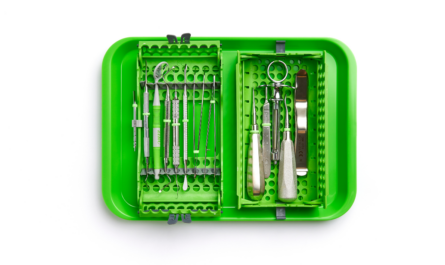By Dr. Sami Bahri, DDS
Symptoms that indicate you’re wasting money
According to Lean management, a dental practice engages in productive work in only 20 percent of the working time.
Even when dental management systems operate as intended, a lean manager would look at how workers move and see either work or waste. Twenty percent of the time, employees engage in activities that patients’ value – value adding (VA) activities or real work. In the remaining 80 percent of the time, they engage in activities that patients don’t value – non-value adding (NVA) activities or waste.
Whether performing work or waste, employees are paid the same amount. Patients, on the other hand, are willing to pay only for work. So, to increase profits, should we improve work or reduce waste?
Dentistry has tried over the years to make work – individual procedures like Impressions, root canal treatments, crown preparations, etc. – go faster. As a result, we gained in efficiency and prevented patient fatigue. But a simple calculation shows that it would be four times more effective to improve what consumes 80 percent of your time than what consumes 20 percent. It is also easier; first, because so many researchers have been improving the 20 percent over so many years, leaving fewer opportunities for further improvement; second, because the 80 percent, wasteful activities, are mainly found in the non-treatment part of dentistry and can be changed without affecting the quality of treatment.
Wasteful activities are sorted roughly in two equal parts. The first 40 percent represent wasteful efforts that are still required to make the present system function, but if you improved the system, you’d be able to remove them. They are called Type One waste or Incidental Work. A good example of incidental work is when you fabricate a temporary crown, take an impression, send it to a lab, and make an additional appointment to seat the permanent crown. If you change the present system by switching to CAD-CAM, all of those steps could be removed.
The next 40 percent represent those activities that create no value to the patient and therefore can be stopped immediately. They are called Type Two waste or Pure Waste. Identifying and removing Type Two waste should be the first step in reducing cost.
During the 80 percent wasteful time, an employee’s salary seems like a cost to the practice. But employees could become a productive asset if you improve another variable, labor density.
Labor density = Work/Waste
It is not enough to remove waste and free up some employee time. You still need to convert that time into real work, reduce the denominator of the equation, by engaging employees in treatment instead of lengthy setups, for example. Converting waste into work is fundamental to lean management; it is your most powerful source of profit.
Many companies connect the idea of converting waste to work with the non-cost principle. It states that once you have decided on the fee for a given service, it becomes a constant figure, but the cost of the service remains variable and subject to reduction. The concept is illustrated in the following formula:
Profit = (Fee – Cost) x Volume
To increase profits, we can increase fees, increase volume or reduce cost. Increasing fees is difficult to achieve if you have competitors in your area or if the fees are imposed by insurance plans. You can increase volume through different marketing methods, but the results are not guaranteed, and seeing more patients does not necessarily mean making more money. The only sustainable way to make profits is to focus on cost reduction.
Of the many factors that generate cost, the most expensive is labor. Fortunately, to help make labor profitable by converting waste into work, lean management offers an abundance of methods, leadership principles and tools. The most basic tool is a classification of wasteful activities into seven categories – defects, waiting, overproduction, transport, inventory, motion, and excessive processing.
This article will discuss the waste arising from defects, the waste arising from waiting and show you how to eliminate them. In a future article, we will discuss the remaining wastes. But I need to caution you here! Waste is only a symptom exposing imperfections in the management system; you need to diagnose its causes, the same way you diagnose the etiology of a toothache.
Defects
Any result that does not conform to an established standard is a defect. It usually generates many ensuing defects as it trickles down to the successive customers. As defined by management guru W. Edwards Deming, a customer is the next person who will use the results of your work. That person could be an external customer – patient – or an internal customer – employee; it could even be you.
Whether defects reach the external or the internal customer, preventing them can lead not only to improvements in quality, but also to considerable gains in productivity. The following is a story from “Just-in-Time for Today and Tomorrow,” by Taiichi Ohno, of a company that quadrupled its manufacturing efficiency when it developed a concept which aims for the total prevention of defects.
ZD [Zero Defects] was a production technique and management routine developed in 1962 by the Martin Company, an aerospace and technology company…
The delivery period for most Defense Department missiles is two months from the order date. However, when a state of emergency required the military to demand that the delivery period be shortened to two weeks, the people involved in missile production discussed how to meet their deadline in each stage of the production process. It was clearly impossible unless they could make a perfect missile the very first time without the tests and readjustments that normally follow final assembly. In other words, they would have to achieve a defect-free product throughout every production stage.
Eliminating the smallest defects at each process stage – from design errors to parts defects to wiring mistakes to final assembly problems – was expected to be extremely difficult. However, the employees and organization had no choice but to succeed. The company successfully met the two-week delivery deadline.
As dental practices, we can emulate the Martin Company and increase profits through defect prevention. Defects can appear anywhere in our operations. They can reach the patient/external customer, or they can affect only the employee/internal customer.
Defects that reach the patient are usually easy to see. They could result from clinical work or from support functions. Clinical defects lead to free-of-charge patient visits. Here are some examples: wrong shade, open margins, ill-fitting restorations, post-operative sensitivity, bite adjustments, denture adjustments, post extraction follow up, etc. – all causing you to spend money without being reimbursed. You can address those defects one by one; prevent most of them and save their cost.
Defects reaching the patient could also initiate in the support functions – errors in insurance filing, billing, scheduling, data entry, etc.
Defects that reach the internal customer (the next employee who will use the information) are much more difficult to see, and much more costly. The real source of profit is to not only prevent them and save the rework time, but to convert that time into productive work.
Defect-proofing or mistake-proofing is an important part of industrial engineering that we have translated into dentistry. It can be treated in a separate article, but I would like to mention here a simple technique that has been very effective in our office, “successive checks.” In this technique, we always ask the next employee to check on our work, and give us immediate feedback when a defect is found. Asking employees to check on our work is perceived as a sign of respect for their opinion, and their taking the time to check, as a sign of respect for our efforts in developing the work.
To say that defects should be prevented might seem like stating the obvious. What was not obvious, however, until I read the Martin Company story, was that defect-proofing could quadruple productivity.
Waiting
Some forms of waste are difficult to discern; others are easier. The easiest to discern is the waste arising from waiting. The dentist could be waiting, the assistant or the patient.
If the dentist is waiting, everyone knows that money is not being generated. That is understandably corrected immediately.
If the assistant is waiting, we usually find it more acceptable. It is true that her wait could maximize the doctor’s time; she would make sure the patient is ready for treatment, and they both wait for the doctor. The doctor can then move between patients without interruption, but the practice could be paying a high price in salaries and equipment for that apparent efficiency. Lean management teaches us to continuously reduce that labor cost through continuous improvement techniques.
If the assistant does not have any productive work available, waiting would be the best thing to do because it shows that she is available to help. But if instead of waiting, the assistant moves around as if she were working, the wait will be hidden under the form of transportation of some materials, or the form of overprocessing, like cleaning some instruments that are already clean or, as we often notice, continuing to explain a treatment plan even after the patient has agreed to it.
What should have been waiting time is now disguised in what looks like work, but in reality, neither does it advance the treatment nor are patients willing to pay for it. We have now transformed the waste of waiting that is easy to see, into other forms of waste that are difficult to see.
To make things worse, sometimes employers contribute unintentionally to that damaging transformation. When they see employees waiting, they often ask them to “go do something,” thus encouraging them to look busy. As a consequence, employees are no more available to assist the patients who are already in the office.
Lean dentists do the opposite. Unless staff members are engaging in a value-adding activity, they ask them to stand idle until they are needed. Employers can then assign productive tasks to the waiting team members, transforming the waiting waste into productive time.
You can transform different types of waste into waiting waste. Because it is visible, the waiting waste is then easily transformed into real work.
Dr. Sami Bahri is the author of “Follow the Learner: The Role of a Leader in Creating a Lean Culture,” and of the DVD “Single Patient Flow: Applying Aplying Lean Principles to Heathcare”. The book won the 2010 Shingo Prize for Research and Professional Publication and the video won the same award for 2013. The Shingo Prize Conference also recognized Bahri as the “World’s First Lean Dentist.” He is a sought-after speaker and lecturer nationally and internationally on implementing Lean management in dentistry. Dr. Bahri can be reached at [email protected]





